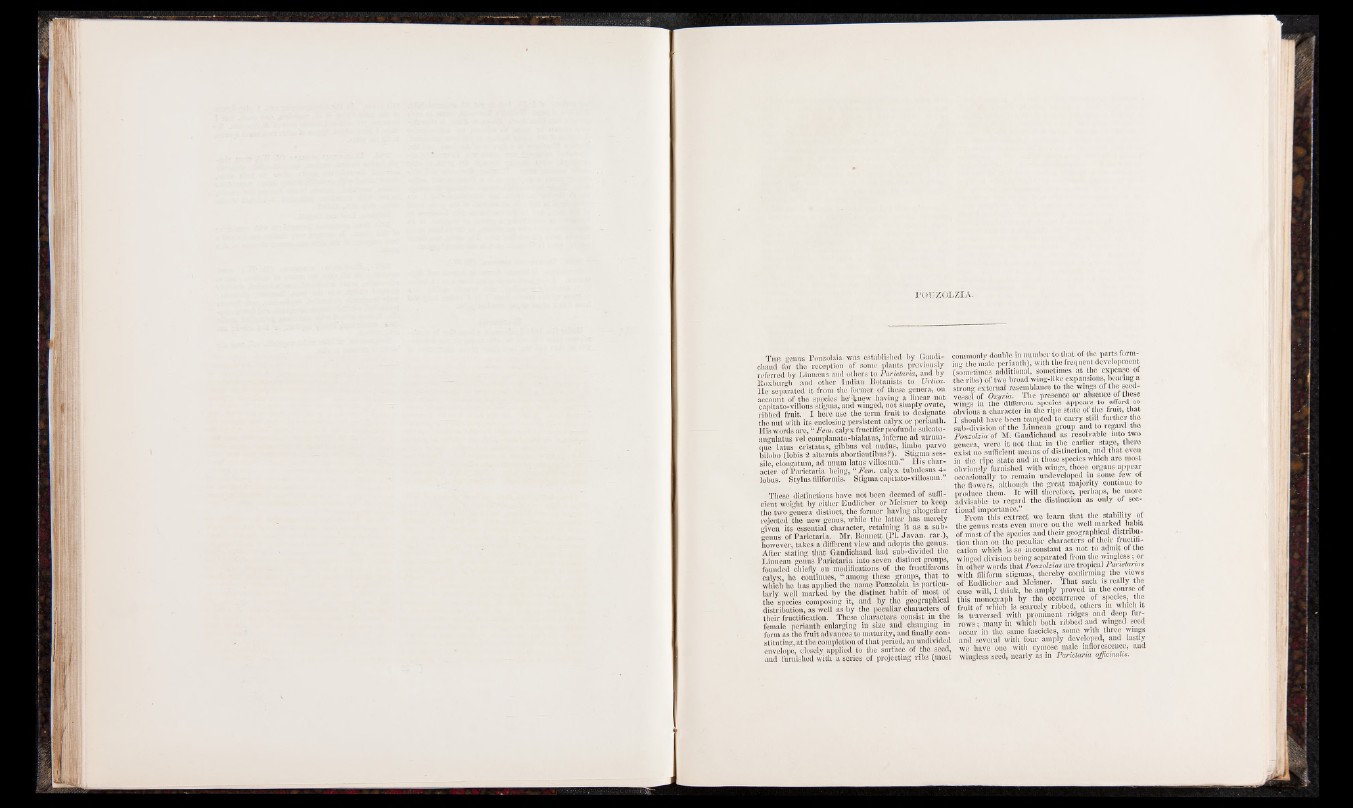
POUZOLZ IA.
T he genus Pouzolzia was established by Gaudichaud
for the reception of some plants previously
referred by Linimis and others to Parietaria, and by
Roxburgh and other Indian Botanists to Urtica.
He separated it from the former of these genera, on
account of the species lie''•knew having a linear not
capitato-villous stigma, and winged, not simply ovate,
ribbed fruit. I here use the term fruit to designate
the nut with its enclosing persistent calyx or perianth.
His words are, “ Fern, calyx fructifer profunde sulcato-
angulatus vel complanato-bialatus, inferne ad utrum-
que latus cristatus, gibbus vel nudus, limbo parvo
bilobo (lobis 2 alternis abortieutibus?). Stigma sessile,
elongatum, ad unum latus villosum.” His character
of Parietaria being, “ Fein, calyx tubulosus 4-
lobus. Stylus filiformis. Stigma capitato-villosum.”
These distinctions have not been deemed of sufficient
weight by either Eudlicher or Meisner to keep
the two genera distinct, the former having altogether
rejected the new genus, while the latter^ has merely
given its essential character, retaining it as a sub-
genus of Parietaria. Mr. Bennett (PI. Javan, rar.),
however, takes a different view and adopts the genus.
After stating that Gaudichaud had sub-divided the
Linncan genus Parietaria into seven distinct groups,
founded chiefly on modifications of the fructiferous
calyx, lie continues, “ among these groups, that to
which he has applied the name Pouzolzia is particularly
well marked by the distinct habit of most of
commonly double in number to that of the parts forming
the species composing it, and by the geographical
distribution, as well as by the peculiar characters of
their fructification. These characters consist in the
female perianth enlarging in size and changing in
form as the fruit advances to maturity, and finally constituting,
at the completion of that period, an undivided
envelope, closely applied to the surface of the seed,
and furnished with a series of projecting ribs (most
the male perianth), with the frequent development
(sometimes additional, sometimes at the expense of
the ribs) of two broad wing-like expansions, bearing a
strong external resemblance to the wings of the seed-
vessel of Oxyria. The presence or absence of these
wings iu the different species appears to afford so
obvious a character in the ripe state of the fruit, that
I should have been tempted to carry still further the
sub-division of the Linncan group and to regard the
Pouzolzia of M. Gaudichaud as resolvable into two
genera, were it not that in the earlier stage, there
exist no sufficient means of distinction, and that even
in the ripe state and in those species which are most
obviously furnished with wings, those organs appear
occasionally to remain undeveloped in some few of
the flowers, although the great majority continue to
produce them. I t will therefore, perhaps, be more
advisable to regard the distinction as only of sectional
importance.” , , , 1 ..... .
From this extract we learn that the stability ot
the genus rests even more on the well marked habit
of most of the species and then- geographical distribution
than on the peculiar characters of their fructification
which is so inconstant as not to admit of the
winged division being separated from the wingless; or
in other words that Pouzolzias arc tropical Parietarias
with filiform stigmas, thereby confirming the views
of Endliclier and Meisner. That such is really the
case will, I think, be amply proved in the course of
this monograph by the occurrence of species, the
fruit of which is scarcely ribbed, others in which it
is traversed with prominent ridges and deep furrows
; many in which both ribbed and winged seed
occur in the same fascicles, some with three wings
and several with four amply developed, and lastly
we have one with cymose male inflorescence, and
wingless seed, nearly as in Parietaria officinalis.